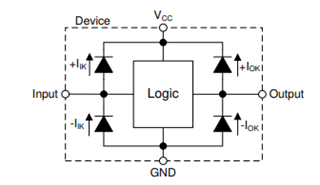Other Parts Discussed in Thread: SN74HC273, SN74AHC8541, SN74AHC273
Hi. Team.
I’m using SN74AHC541N , SN74AHC8541N , SN74HC273N and SN74AHC273PWR.
I have some questions to undershoot of VI and VO.
The undershoot may be exceeded -0.5V in the application. which exceeding abs max rating of VI and VO.
Each devices datasheet say “The input and output voltage ratings may be exceeded if the input and output current ratings are observed.” .
So I believe each device can exceed -0.5V as long as IIK and IOK are lower than -20mA and ±20mA respectively.
It is my understanding. correct?
If so , could you advise damping resistor value to suppress the current for each devices?
Thanks.
Regards,
Tsuyoshi




